Low Dog (Sunka Kucigala) was
a young Oglala at the time of his transfer to the Standing
Rock Agency in the summer of 1881, giving his age as 34
[born c1847]. William Garnett refers to him as an "upstart".
He surrendered in 1881, he lived on the Standing Rock
Reservation (not Cheyenne River). He was still on Standing
Rock as late as 1920. —
Ephriam Dickson

I
have a copy of a letter dated 1890, which tell of the
arrest of Low Dog for supposedly trying to kidnap the
young son of Big Foot, he did not want to attend school
apparently, { some other notes hint that the two men may
have been related,} as a result, he was subsequently and
imprisioned at Fort Snelling. However, on the strength
of a letter from the local Indian agent, he was released
a few months later and escorted back to Cherry Creek where,
and here I quote the letter, "he was to be returned
to his own people.''
As you probably know, Cherry Creek was on the Cheyenne
River agency. Richard Hardorff mentions him in several
of his books, but in two of them, he talks of him living
and dying at Cherry Creek, but frustratingly, gives two
very different years for his death, off the top of my
head they were 1896 and 1910, quite a difference i think
you'll agree.
— David Shanahan

Hardorff,
in his book, THE DEATH OF CRAZY HORSE, does say that Low
Dog settled at Cheyenne River Agency and that he died
in 1894 (p. 86). He cites two references: Graham's book
CUSTER MYTH (which does not include this information)
and a general reference to the Camp Collection at Indiana
University (of which I do not have a copy to check). I
assume that Camp's notes must be his source for this biographical
information.
Low
Dog is listed in the 1881 Standing Rock Census which shows
the recently surrendered "hostiles" three months
after their arrival at Standing Rock, including:
Sunka
kucigala Low Dog M 34 [born c1847]
Pejuta Medicine wife F 35
Kokam corsica One Who Makes Disorder son M 11
Sunka kan Horse son M 2
I
also have in my notes two references to a Joshua Low Dog
(born about 1847-49) which I have assumed to be the same
individual (though I might be incorrect here):
Low
Dog, Joshua 52
Low Dog, Louise wife 53
Low Dog, Louise dau. 18
Low Dog, Luke son 15
Low Dog, Jessie dau 13
His
wife, Louise's, Lakota name is given as Tiolutawin, which
might translate as Red Lodge (I will have to check on
that to be certain). This is from the 1900 Federal Census
for Standing Rock Agency (p. 293).
Then,
in the 1910 Federal Census for Standing Rock Agency (p.
78):
Low
Dog, Joshua 61
Low Dog, Luke son 25
Low Dog, Regina dau-in-law 20
Low Dog, Louise dau 28
Low Dog, Willa gr-dau 5
In
this census, Joshua Low Dog is listed as a widow, with
the note that he had been married twice. Also, he lists
himself as a Sans Arc, not an Oglala. (His first wife
may have been an Oglala and he might have joined this
tribe following their marriage, a common occurrence among
the Lakota).
I
could not find him in the 1920 federal census.
One
way to document if this is the same Low Dog would be to
follow him through the annual agency census records. I
have access to those here, but have not gone through them
looking for Low Dog. The first one for Standing Rock Agency
begins in 1885 and continues into the twentieth century.
According to my notes, there may not be census records
for the 1894 to 1900 period for Standing Rock. When I
have some time, I will go through them to see what I can
find.
In
the Standing Rock issue [of Donovin Sprague´s books],
he includes a photograph from the Smithsonian of Low Dog,
along with Crow King, Major Brotherton and George Fleury,
taken in 1881. Sprague wrote the following about Low Dog:
"Low Dog is always listed as an Oglala but is a Siha
Sapa. His family went south and Cheyenne River Sioux tribal
member Carideo Low Dog of Dupree, SD is the great grandson
of Chief Low Dog." (p. 56) —
Ephriam Dickson

Three
D.F. Barry photos of Low Dog:
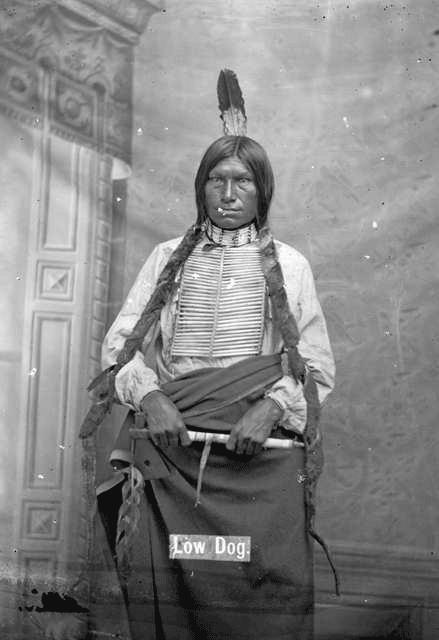
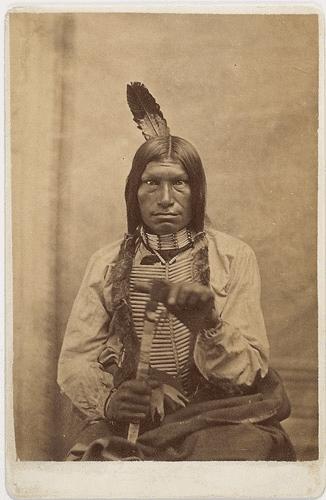
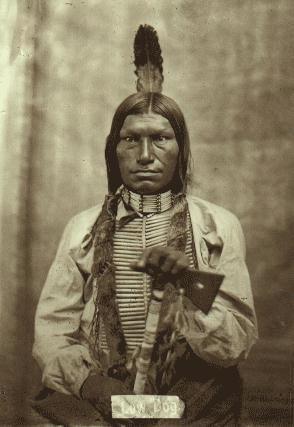
—
Dietmar Schulte-Möhring

Here's
yet another picture of Low Dog, clearly from the same
session as those above, but with the added bonus of Crow
King. I scanned this from Paul Hedren's booklet, 'Sitting
Bull's Surrender at Fort Buford':
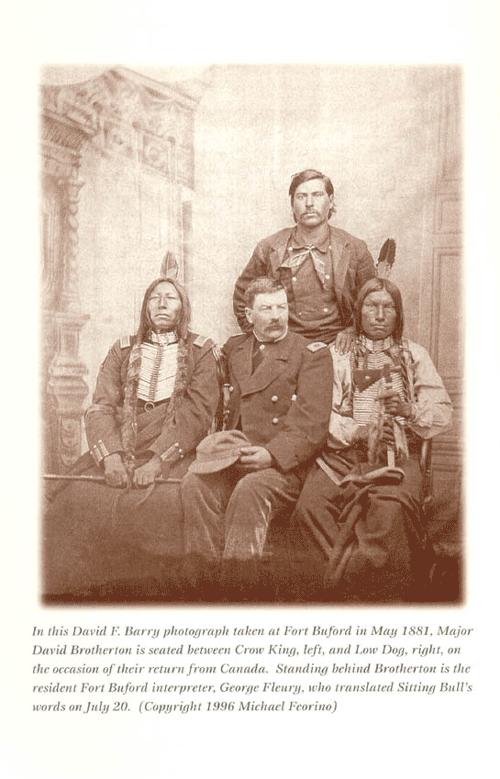
—
Grahame Wood

This
photo certainly is the earliest portrait of Low Dog, the
second one should be his latest likeness, depicting him
as an older man with short hair:
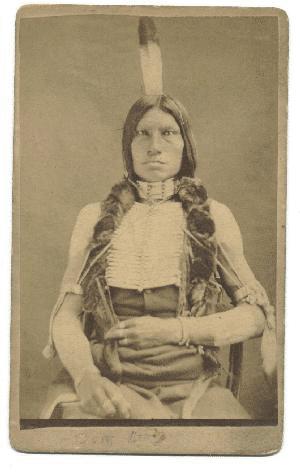
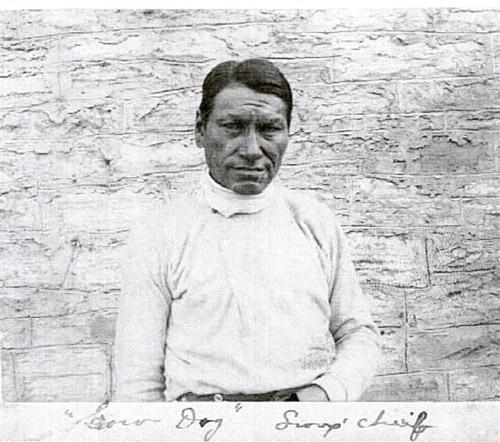
The
first image obviously depicts a younger Low Dog than those
pictures taken shortly after his return from Canadian
sanctuary. If not taken immediately before his Canadian
sojourn (which potential photographer was around?), the
portrait could well have been done in Canada - although
somehow I am still inclined to slightly doubt this (photographer?).
—
Hans Karkheck

The
second photo in the Minnesota Historical Society Visual
Recources Database. It states the photographer is Edward
Augustus Bromley (1848-1925). The picture was made in
1891. —
Dietmar Schulte-Möhring

I
guess what we need to know is did Low Dog surrender in
1877? With Crazy Horse? If so, he must have been using
another name - and not White Guts - for he isn't in Buecker
and Paul's 'Crazy Horse Surrender Ledger', so he doesn't
appear to have been at Red Cloud (unless he's one of those
listed as Guts) at this time. Did he then leave for Canada
after Crazy Horse's death, or did he go straight to Canada
with Sitting Bull after LBH?
In 'Indian Views of the Custer Fight', Hardorff suggests
that Low Dog went straight to Canada with Sitting Bull,
but in his book on the death of Crazy Horse, he says he
surrendered in May 1877 then left for Canada later.
I'm assuming, perhaps incorrectly, that he hadn't been
at an agency prior to 1877 at least. If he initially surrendered
in 1877, then the photograph could date from the brief
time he was at the agency (but which agency???). Could
be a Morrow, a Hamilton, a Mitchell, a Goff? Was it taken
in Canada? There certainly were photos of Sitting Bull's
people taken in Canada, but not many seem to have surfaced
and there are some passed off as Lakota that clearly aren't.
Was it taken almost straight after his surrender in 1881?
A Haynes? A Barry? A Huffman? There looks to be more than
10 years between the two photos Hans posted, but then
Sitting Bull's features aged noticeably during this period...
As I'm sure you know, when the reporter John Finerty visited
Sitting Bull in Canada in 1879, he referred to Low Dog
as 'brave and sullen. He had little to say, but was a
man of considerable action when it came to blows."
On the other hand, Finerty also refers to a man called
White Guts, the other name by which he is referred in
DeCost Smith's book, as "tall, thin, and gaudily
dressed, young but hard looking, with the reputation of
being a good fighter." —
Grahame Wood

I
would guess that the photograph of a younger Low Dog was
taken some 5\6 years previous to those that we are all
now so familiar with, those taken around the time of his
surrender, the reason I say this is because to me, the
face looks less lined, much less careworn.
Beside his face, there are a couple of things that indicate
that the Photo was taken at some other time. The braid
wraps he wears appear to be much thicker than those he
wears in the surrender photos, although he does seem to
be wearing the same neck choker and bone breastplate.
But what on earth are those strange pieces of string or
rope that seem to pass from behind his head, over his
shoulder, and then link with those things he wears on
his arms? I for one have never seen anything like them
in any of the thousands of photographs of plains Indians
I have looked at over the years.
With regard to the later photo, I wonder if it was taken
either whilst he was a prisoner at Fort Snelling in Minnesota,
{ he had been arrested at the time of the Ghost Dance,
as it was felt that he was one of the men fermenting trouble,}
or, if not, then on his return to Cherry Creek. He was
released in August 1891, and escorted by a non commissioned
officer to Fort Bennet, and from there, he was given yet
another escort that took him back to the Cheyenne river
agency, for, as the order has it, " restoration to
his people. What a long, strange trip that must have been
for the men concerned.
— David Shanahan

Low
Dog enrolled at Spotted Tail Agency with the surrendering
Lame Deer village on September 4, 1877.
—
Dietmar Schulte-Möhring

Edward
Bromley took a good number of photographs at Fort Snelling
over the years, which, I think, strengthens my case for
him having taken that photograph of Low Dog when he was
a prisoner there in 1891. —
David Shanahan
I
found an interesting statement about Low Dog in "Standing
Rock Sioux - Images of America" (Arcadia 2004). The
author Donovin A. Sprague is himself a tribal member of
the Cheyenne River Sioux:
"Low Dog is always listed as an Oglala but is a Siha
Sapa."!!!
He seems to have got this information
from Carideo Low Dog of Dupree, South Dakota, who is the
great-grandson of Low Dog. —
Dietmar Schulte-Möhring

Here's
a plate from the Dover reprint featuring the band leaders:
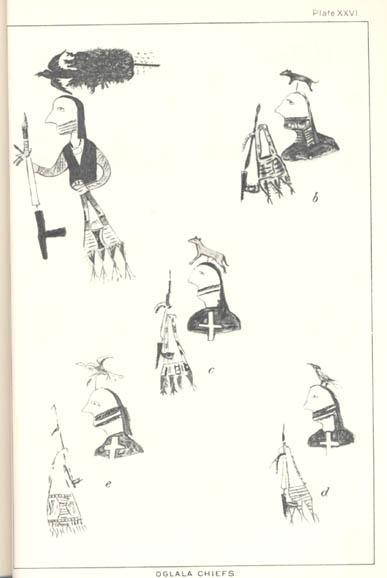
b
- Low Dog
c - Long Dog
d - Iron Crow
e - Little Hawk
The
pictograph of Low Dog with name glyph is to be found in
Garrick Mallery's 'Pictographs of the North American Indians:
A Preliminary Paper', 4th Annual Report of the Bureau
of American Ethnology, Washington DC, 188m 6; pp 175-176,
and the relevant plates. There is no information about
him specifically; he's just listed as a band leader under
Big Road. Mallery intially syas they represent the 84
heads of families in Big Road's band and were collected
by the Rev S D Hinman in 1883 from agent James McLaughlin,
who obtained them from Big Road when he was brought to
Standing Rock and had to give an account of who was in
his band. The originals were made with black and coloured
pencils, with a few in yellow ochre water colour on single
sheets of foolscap paper with materials acquired from
the agency.
The
first figure in each of the seven plates is a chief of
the sub-band or head of 'family'. The leaders' rank is
shown by the presence of a pipe and bag. The pipe bag
of each leader is different; some of the leading figures
don't have pipes or bags and Mallery feels this may because
they all belong to the previous leader - which suggest
the largest of the bands may have been Low Dog's. There
is no suggestion that the individual Indians were responsible
for their own images; in fact, they seem to be all by
one hand (Big Road's, I assume) - although there are a
few on plate which may be the product of a different artist.
Some
of the drawings also appear in Garrick Mallery's Picture
Writing of the American Indians; two volumes, Dover Publications,
Inc., New York, 1972, which was a reprint of his 'Picture
Writing of the American Indians', in the Tenth Annual
Report of the Bureau of Ethnology to the Secretary of
the Smithsonian Institution, 1888-89, by J W Powell, Director,
originally published by the Goverment Printing Office,
Washington DC, 1893. In Volume One, pp 420-423 and relevant
plates, Mallery has reproduced the heads of the band leaders
and the head soldiers (indicated by the presence of a
war club and three transverse bands of red paint on their
cheeks. Each of the chiefs have different designs of pipes
and bags and at least three transverse bands painted on
their cheeks. All he says about Low Dog is that the dog
figure is represented as 'low' by the shortness of the
legs as compared with the figure of Long Dog. —
Grahame Wood

You may notice that in the 1885 annuity list that you
mentioned, there are actually two individuals named Low
Dog. One is in Bear Looking Back's band (Hunkpapa) and
the other is listed in Charging Bear's band (Blackfeet).
Both of these men are also listed in the 1885 Standing
Rock Agency census. The Hunkpapa Low Dog gave his age
as 46, suggesting he was born about 1839 (too early to
be the Oglala Low Dog). I do not have a copy of the Blackfeet
portion of that census here at the house, so will have
to look up the other Low Dog's age on the microfilm.
Since
we last corresponded, I can add a couple of details about
Low Dog. As we all know, he was at Standing Rock Agency
with his family in 1881, transferred there from Fort Buford.
He appears in both the Big Road Roster and the Sitting
Bull Surrender Census that fall. Low Dog's band is shown
in the Dec. 1881 annuity list with 22 families.
In
another ledger for the Pine Ridge Agency, Low Dog and
most of the 22 families in the SRA annuity list are shown
as transfers. This shows that Low Dog and his band were
transferred with the other Oglala to Pine Ridge in May
1882. Unfortunately, there is a gap in the Pine Ridge
records between 1882 and 1886, so we do not yet know when
Low Dog left Pine Ridge. He is not listed in the Pine
Ridge Agency census for 1886. But we have the two Low
Dogs at Standing Rock in 1885.
Finally,
I have some question about the identification of Low Dog
surrendering at Spotted Tail in 1877. The Spotted Tail
Agency ledger book does list the families that came in
from the late Lame Deer's band in September 1877 and there
is an entry for someone named Low Dog or Law Dog (page
64). However, this individual gives his tribal affiliation
as Wajaje Brule. This person is gone by the time the next
census at Spotted Tail was conducted in Dec. 1877. I am
not convinced that this is him. —
Ephriam Dickson

I
looked up the Blackfoot Lakota Low Dog in the Standing
Rock Agency census records. He appears every year between
1885 (the first year of the Standing Rock census) through
1891 (the last year I looked at today). This Low Dog was
born about 1848 (or 1846 according to the 1890 and 1891
census). His family includes:
Two
Horses, wife (born c1853-54)
Returns Last; later known as Thomas Low Dog, son (born
c1870-71)
Uses His Bow, son (born c1879)
Comes Walking, daughter (born c1880-81)
Kill the Number or Kill Nearby, son, (born c1886)
Henry Low Dog, son (b.c1887)
Madaline Low Dog, (born c1889)
There
is some correlation for this individual to our Oglala
Low Dog who is recorded in the Sitting Bull Surrender
Census for 1881:
Low
Dog (born c1847)
Medicine, wife (born c1848)
One Who Makes Disorders, son (born c1870)
Horse, son (born c1879)
— Ephriam Dickson

I
remain convinced that the famous Low Dog is the Low Dog
(or "Law Dog") listed in the Spotted Tail Agency
census as surrendering from the north on Sept. 4, 1877,
with the advance guard of Fast Bull's camp (formerly Lame
Deer's). This is because Wm. Garnett in his 1907 interview
with Judge Ricker stated that Low Dog led the breakout
for Canada during the agency removal to the Missouri River,
Nov. 1877. Garnett stated: "Low Dog, a northern chief
an upstart who belonged to the Lame Deer band and was
a brave man, he led these Indians off." Granted that
probably all these Indians had multiple names, but no
one else in the Fast Bull camp is listed as Low Dog. Ephriam
is right, the name seems to read 'Law Dog', but what I
suspect you have here is the master census roll being
copied from more rudimentary field entries. This particular
census has many obvious misreadings or mis-spellings,
often confounding 'o' and 'a'.
Incidentally,
what is dramatic here is the fact that the bunch of people
including Low Dog (the headman was noted as Shedding Bear,
a Miniconjou) had joined the Northern village on Beaver
Creek below Spotted Tail Agency late on Sept. 3. With
three of the four Northern village Deciders they came
up to the agency on the morning of the fourth to be enrolled.
At precisely the same time the Army had marched from Camp
Robinson in its bid to arrest Crazy Horse, who of course
fled to the Northern village at Spotted Tail. My hunch
is that Crazy Horse knew of the surrender of Fast Bull's
camp, and hoped to tip the fragile balance in the Northern
village and provoke a general outbreak. In this of course
he failed.
We
know nothing about Low Dog's parentage, so he may have
counted Wazhazha/Brule antecedents. He seems to have been
unusually well-travelled even by contemporary Lakota standards,
having connections to the Hunkpapa and Miniconjou as well
as the Oyuhpe band of Oglalas with whom he usually "ran".
He seems never to have settled permanently at any one
agency even after the final surrenders of 1881 - so I
suspect he is the Low Dog counted as a Ghost Dance agitator
at Rosebud. Clearly a lot more research waits to be done
on his remarkable life. The astonishing photo of him with
the short hair, side parting - and I don't think he looks
remotely subservient or 'tamed' - is one more proof of
the man's elusive, mercurial quality. —
Kingsley Bray

I
too am pretty sure that my man Low Dog is the same man
as the Low Dog the Brule, mistakes are easily made by
all of us. As an example, a piece of information I came
across referred to a request to arrest a Lodog, probably
Low Dog, Big Foot, Pretty Hawk and Hump, this being just
prior to Ghost Dance outbreak, the reasons given was that
they were thought to be potential trouble makers. Low
Dog was eventually arrested almost immediately after the
fighting, apparently because he tried to " kidnap
a boy who had been brought from Pine Ridge as a prisoner,
along with a few survivors. " Low Dog was eventually
imprisoned at Fort Snelling, where incidentally, I think
that photograph of him with short hair was taken.
Attached to this information, was a newspaper clipping
about the arrest and its subsequent outcome, which mistakenly
named the man arrested in this case as as Crow Dog. So
as you can see that we have a little problem with all
these various dogs, be they Low, Long, or Crow. —
David Shanahan

Low
Dog footnote: On the 1882 Pine Ridge Ration Roll, the
recent transfers from Stending Rock are listed with the
notation "North" against their names. Low Dog,
ration ticket 1065, with 6 people in his household, has
a further notation, which reads "[?] to Cheyenne
Ag." This notation is then deleted. The mark indicated
by my question mark may be a number. Underneath that notation
is another: "2 to 576". The figure of 6 (people,
total in household) is then deleted and replaced by 3
- or possibly 5 - quite possibly first by 5, then overwritten
to 3. Ephriam might like to compare my reading of this
difficult line.
Ticket
no. 576 was held by Old Beaver, also notated as "North".
The original number of people is written 4, deleted and
replaced by 5. The notation "1 from 1065", i.e.
from the Low Dog household, is added to the line. To complicate
it all again, Old Beaver's name is deleted and replaced
by One Man. Possibly this is Isna Wica, Lone Man, one
of He Dog's brothers.
Unlike
most households noted as "North", that of ticket
no. 576 has a number indicating membership in one of the
regular agency Oglala bands - in this case, no. 2, referring
to Young Man Afraid of His Horse's band, the Payabya.
— Kingsley Bray

I heard Low Dog is laying along the Owl (Morrow) River.
His last surviving direct descendant is living in Dupree.
His name is Creedio Low Dog.
— Brock